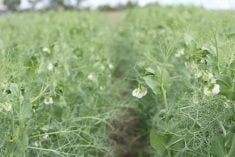Statistics Canada released its latest Canadian livestock inventory report Aug. 16.
The number of farms reporting hogs is now 11,497, down 25.7 percent from 2001. But the average farm now has 1,308 hogs, up 45 percent from 2001.
The largest farms are in Manitoba, with an average inventory of 2,468 head in 2006, up 62 percent from 2001.
The report suggests that overall, the Canadian breeding herd is down one percent and grow-finish inventories are down six percent. That is reflected in the four percent increase in the number of weanling and feeder pigs weighing less than 20 kilograms. It suggests less finishing, more exports of weanlings and feeders and a gradual decline in the breeding herd.
Read Also

Phosphate prices to remain high
Phosphate prices are expected to remain elevated, according to Mosaic’s president.
Total Canadian slaughter looks like it will be one to four percent below 2006 levels over the September to November period.
Production is expected to be about the same as last year. Eastern Canadian weanling, feeder and market hog exports are down sharply from 2006 levels, resulting in more production being raised.
Eastern Canadian slaughter may be one to two percent higher than 2006 in October-November. Year-to-date slaughter in Canada is down 2.9 percent overall.
The table above takes in western Canadian (Alberta, Saskatchewan and Manitoba) export and domestic slaughter information and pairs this with April-June pig crop numbers.
The weanling and feeder pig exports that will influence September to November marketings were shipped from mid April to mid July.
Market hog exports for the fall are projected based on the last 18-week average. Western Canada has a two percent higher production based on the pig crop for April to June.
Weanling, feeder and market hog exports will likely reduce September to November slaughter by seven to 12 percent compared to 2006. In Western Canada, year-to-date slaughter is down 8.4 percent from 2006 as of Aug. 11, 2007. This forecast suggests that the slaughter reduction will increase from this level in November.
North American production (see table below) is set to increase one to 1.5 percent overall for the September to November period. The forecast is based on pig crop data. It suggested 0.5 percent higher slaughter from January to June and it is up 1.4 percent. For July, two percent higher slaughter was predicted, but it is up 4.2 percent.
This could be related to improved performance of circovirus-vaccinated pigs. Many operations began vaccination programs in late winter. The vaccine has proven highly effective and vaccinated market hogs should have been hitting market weight by mid June.
The pig crop data suggests that the number of pigs produced has not increased dramatically, but their growth rate has likely improved. When growth rates improve broadly, there is a doubling up of sales as faster growing pigs catch up to slower growing ones, but the effect should ebb after three months or so. If the surge started in July, it may be done by the end of September. The September U.S. Hogs and Pigs report, due at the end of September, will provide a better forecast for the November-January market numbers.
Domestic demand in the United States has been strong this year and margins between retail and lean hog prices have been excellent. Exports of poultry and beef have been improving, making up for lagging pork exports.
The U.S. Department of Agriculture July cold storage report released Aug. 22 indicated total meat in storage for that month at 97 percent of 2006 levels. Unfortunately, pork stocks were 10 percent higher, due mainly to a buildup of hams.
U.S. pork exports for June were released Aug. 16. Year-to-date exports are behind 2006 by six percent in volume, but are actually ahead five percent in dollars. The only major U.S. customers to show declining dollar purchases of U.S. pork are Mexico and Russia, down 26 and 19 percent, respectively.
There are rumours that China will buy up to 70,000 tonnes from the U.S. between mid September and mid October. The Chinese require pork to be free of Paylean and they have delisted a number of major U.S. plants that cannot reliably supply it. The resolution to this is unclear, but it only takes about 30 days to produce Paylean-free pork, so if it is required, the situation will likely be corrected.
If this amount of pork is purchased, it would be almost three times the volume China-Hong Kong has bought this year to date and is close to the total amount of pork exported by the U.S. in June. We’ll see.
It appears that high corn prices have led to liquidation in the Mexican herd and expensive tortillas. This is a significant cost issue for Mexican consumers, affecting meat demand.
Some analysts feel the liquidation is slowing and corn prices have moderated, so there is significant potential for an upturn in U.S. exports to Mexico the next few months.
Over the last four years, prices have been much stronger than long-term seasonal patterns would suggest in the fourth quarter. This year may work out the same way.
The big difference this year is that hog supplies look larger and the futures market has priced a lot of fall strength in already. Current Brandon Signature 3 prices are in the $130-$135 per 100 kilogram range.
We could expect prices in the $114-$121 per ckg range for the fourth quarter, with current exchange rates and normal seasonality.
The futures market is suggesting fourth quarter prices of $123 per ckg ($1.06 exchange rate). The greatest producer price risk is likely from early November to mid January 2008.
David Kraut has provided market and risk management information to swine producers for eight years. This column appears after each quarterly U.S. Department of Agriculture hogs and pigs report and Statistics Canada hog inventory report.














